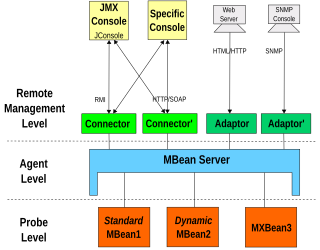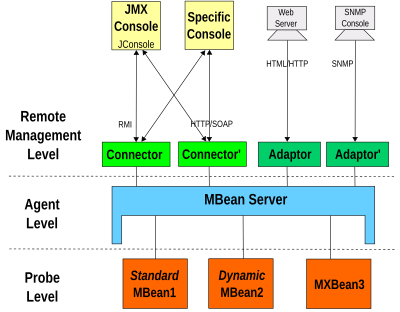
OSGi is an open specification and open source project under the Eclipse Foundation. It is a continuation of the work done by the OSGi Alliance, which was an open standards organization for computer software founded in March 1999. The foundation originally specified and maintained the OSGi standard. The alliance transferred its work to the Eclipse Foundation at the end of 2020. The OSGi specification describes a modular system and a service platform for the Java programming language that implements a complete and dynamic component model, something that does not exist in standalone Java or VM environments. It has a service-oriented architecture based on micro services each implemented as an extended Java class file archive.
Jakarta Enterprise Beans is one of several Java APIs for modular construction of enterprise software. EJB is a server-side software component that encapsulates business logic of an application. An EJB web container provides a runtime environment for web related software components, including computer security, Java servlet lifecycle management, transaction processing, and other web services. The EJB specification is a subset of the Java EE specification.
The Jakarta Transactions, one of the Jakarta EE APIs, enables distributed transactions to be done across multiple X/Open XA resources in a Java environment. JTA was a specification developed under the Java Community Process as JSR 907. JTA provides for:
The Jakarta Messaging API is a Java application programming interface (API) for message-oriented middleware. It provides generic messaging models, able to handle the producer–consumer problem, that can be used to facilitate the sending and receiving of messages between software systems. Jakarta Messaging is a part of Jakarta EE and was originally defined by a specification developed at Sun Microsystems before being guided by the Java Community Process.

Jakarta EE, formerly Java Platform, Enterprise Edition and Java 2 Platform, Enterprise Edition (J2EE), is a set of specifications, extending Java SE with specifications for enterprise features such as distributed computing and web services. Jakarta EE applications are run on reference runtimes, that can be microservices or application servers, which handle transactions, security, scalability, concurrency and management of the components it is deploying.
Java Data Objects (JDO) is a specification of Java object persistence. One of its features is a transparency of the persistence services to the domain model. JDO persistent objects are ordinary Java programming language classes (POJOs); there is no requirement for them to implement certain interfaces or extend from special classes. JDO 1.0 was developed under the Java Community Process as JSR 12. JDO 2.0 was developed under JSR 243 and was released on May 10, 2006. JDO 2.1 was completed in Feb 2008, developed by the Apache JDO project. JDO 2.2 was released in October 2008. JDO 3.0 was released in April 2010.

Apache Tomcat is a free and open-source implementation of the Jakarta Servlet, Jakarta Expression Language, and WebSocket technologies. It provides a "pure Java" HTTP web server environment in which Java code can also run. Thus it is a Java web application server, although not a full JEE application server.
Jakarta Faces, formerly Jakarta Server Faces and JavaServer Faces (JSF) is a Java specification for building component-based user interfaces for web applications and was formalized as a standard through the Java Community Process being part of the Java Platform, Enterprise Edition. It is also an MVC web framework that simplifies the construction of user interfaces (UI) for server-based applications by using reusable UI components in a page.
Jakarta Connectors is a Java programming language tool for connecting application servers and enterprise information systems (EIS) as part of enterprise application integration (EAI). While JDBC is specifically used to connect Java applications to databases, JCA is a more generic architecture for connection to legacy systems. JCA was developed under the Java Community Process as JSR 16, JSR 112 and JSR 322.

MX4J is a project to create an open-source implementation of Java Management Extensions (JMX). The JMX specification is a Java Specification Request currently in maintenance release 1.2; the new JSR 160 has been issued to address connectivity to a remote JMX agent. MX4J implements both JSR 3 and JSR 160.
Hibernate ORM is an object–relational mapping tool for the Java programming language. It provides a framework for mapping an object-oriented domain model to a relational database. Hibernate handles object–relational impedance mismatch problems by replacing direct, persistent database accesses with high-level object handling functions.

JOnAS is an open-source implementation of the Java EE application server specification, developed and hosted by the OW2 consortium, having been originally been created by Groupe Bull. JOnAS is released under the LGPL 2.1 open-source license.
WebSphere Application Server (WAS) is a software product that performs the role of a web application server. More specifically, it is a software framework and middleware that hosts Java-based web applications. It is the flagship product within IBM's WebSphere software suite. It was initially created by Donald F. Ferguson, who later became CTO of Software for Dell. The first version was launched in 1998. This project was an offshoot from IBM HTTP Server team starting with the Domino Go web server.
Apache Beehive is a discontinued Java Application Framework that was designed to simplify the development of Java EE-based applications. It makes use of various open-source projects at Apache such as XMLBeans. Apache Beehive uses Java 5, including JSR-175, a facility for annotating fields, methods, and classes so that they can be treated in special ways by runtime tools. It builds on the framework developed for BEA Systems Web logic Workshop for its 8.1 series. BEA later decided to donate the code to Apache.
In software engineering, a WAR file is a file used to distribute a collection of JAR-files, JavaServer Pages, Java Servlets, Java classes, XML files, tag libraries, static web pages and other resources that together constitute a web application.
The Spring Framework is an application framework and inversion of control container for the Java platform. The framework's core features can be used by any Java application, but there are extensions for building web applications on top of the Java EE platform. Although the framework does not impose any specific programming model, it has become popular in the Java community as an addition to the Enterprise JavaBeans (EJB) model. The Spring Framework is open source.
Jakarta PersistenceAPI is a Jakarta EE application programming interface specification that describes the management of relational data in enterprise Java applications.
The JBoss Enterprise Application Platform is a subscription-based/open-source Java EE-based application server runtime platform used for building, deploying, and hosting highly-transactional Java applications and services developed and maintained by Red Hat. The JBoss Enterprise Application Platform is part of Red Hat's Enterprise Middleware portfolio of software. Because it is Java-based, the JBoss application server operates across platforms; it is usable on any operating system that supports Java. JBoss Enterprise Application Platform was originally called JBoss and was developed by the eponymous company JBoss, acquired by Red Hat in 2006.

WildFly, formerly known as JBoss AS, or simply JBoss, is an application server written by JBoss, now developed by Red Hat. WildFly is written in Java and implements the Java Platform, Enterprise Edition specification. It runs on multiple platforms.
Jakarta Management is a Java specification request (JSR-77) for standardization of Jakarta EE server management. Jakarta Management abstracts the manageable parts of the Jakarta EE architecture and defines an interface for accessing management information. This helps system administrators integrate Jakarta EE servers into a system management environment and also helps application developers create their own management tools from scratch.







